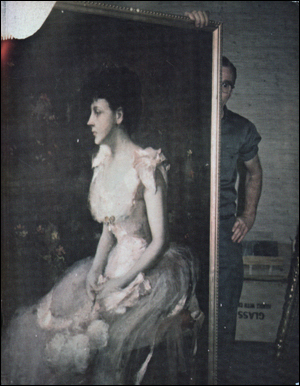
Exhibition catalogue published in conjunction with show held at the Institute for the Arts, Rice University, Houston, October 29, 1969 - January 4, 1970. Traveled to The Isaac Delgado Museum, New Orleans, January 17 - February 15, 1970; and Museum of Art, Rhode Island School of Design, Providence, April 23 - June 30, 1970. Texts by Daniel Robbins and David Bourdon. Catalogue by Stephen E. Ostrow.
So they set Andy Warhol loose in the storage area of the Museum of Art at RISD [aka "The Icebox"] and the exhibition became what he found there and selected for the exhibition. Artist as curator. But rather than choosing painting, sculpture, and drawings, he curated a rich show incorporating decorative arts too - Bandboxes and Hatboxes; Baskets; Ceramics; Chairs; Costume Accessories, Footwear, Parasols and Umbrellas; Textiles and Wallpaper.
The pale bedraggled figure, laden down with tape recorder, camera, movie magazines and a minimal entourage, staggered into the Director's office of the Museum of Art, Rhode Island School of Design. Daniel Robbins, the energetic young Director of the museum, leaped from his desk to greet him, gloating: "We're going to have a lot of fun today. What are you doing?"
Andy Warhol wasn't sure. He had been invited to Providence to rummage through the basement storage areas of the museum and to select anything that caught his eye.
The works of art that he selected would be transplanted to Houston where they would be installed under his direction in a show at Rice University. The show, which was called "Raid the Icebox," would then travel to New Orleans and eventually wind up its tour in the special exhibition galleries at the Rhode Island School of Design, where the residents of Providence would be able to see (often for the first time) works of art that had been lying dormant for years in their very own basement.
The show was conceived by John and Dominique de Menil, who wanted to bring out into the open some of the unfamiliar and often unsuspected treasures moldering in museum basements, inaccessible to the general public. The idea runs counter to the usual practice of assembling large shows of "key" works from particular schools or periods, weeding out the misfits and the also-rans, which are thereby consigned to storage. Andy Warhol consented to go underground in Providence, and to cast his innocent, non-curatorial eye upon objects that had been scorned and forgotten for decades. By resurrecting some cast-offs, "Raid the Icebox" restores some of the cultural fabric of the past, seen now in a fresh perspective through the contemporary eyes of Warhol.
"There are 45,000 objects in this museum, many of which are falling apart," said Robbins, leading us down to the basement. "We can go into dark places where people haven't been for years." But he started off, safely enough, in a large musty room housing the costume collection. He approached a large wooden cabinet and opened all five doors to reveal the museum's impressive shoe collection-an orderly arrangement of hundreds of shoes of all sorts: ballet shoes, boots, men's dress shoes, children's shoes, sabots, ladies' dress shoes, most of them dating from the mid-nineteenth century to the 1950s. Warhol appeared mesmerized, probably because the series of shoes reminded him of the repetitive images, such as the Coke bottles and soup cans, in his own Pop paintings. Perhaps the shoes also invoked memories of the mid-'sos, when Warhol was a highly successful commercial illustrator, whose whimsical artwork for I. Miller shoe ads won him awards and caused him to be called "the Leonardo da Vinci of the shoe trade."
Warhol wanted the entire shoe collection. Did he mean the cabinet as well? "Oh, yes, just like that." But what about the doors? Would he allow people to open and close them? "Spectator participation," Warhol murmured. Robbins was startled. No curator, he said, would have thought of exhibiting the shoes "just like that." -- from book's introduction